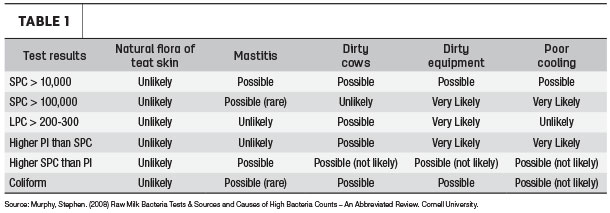In 2017, nearly 9.4 million dairy cows in the U.S. produced 215 billion pounds of fluid milk. With that much milk, you could fill 3,100 large tanker trucks, take a dip in 38 Olympic-sized swimming pools of milk or give every single American a bowl of cereal with milk for breakfast – and then some.
A lot of milk is produced in the U.S. – even compared to the rest of the world. We are one of the top five highest milk-producing countries on the planet.
But how good (aka clean) is our milk?
Actually, it’s pretty clean – and getting cleaner. In 2017, the average somatic cell count of DHI herds was 197,000 cells per milliliter, the lowest ever since recording started in 1995. This result is well below the 750,000 cells per milliliter threshold acceptable for Grade A producers.
While the quality of our milk keeps getting better, that doesn’t mean it’s not an ongoing consideration of pretty much every U.S. dairy producer. After all, quality milk is worth a premium. But producing it depends on so much: the health of the herd, the sanitation and cleaning of equipment, the education of employees, the cooling process … what more?
With so many pieces in the milk quality puzzle, how do you know what to fix when there is an issue?
In my 40 years of experience working with milk producers and dairy processors and their field representatives, I’ve developed a step-by-step checklist to help pinpoint the source of high bacteria counts in milk:
1. Look at the system
Perform a visual check of the system, and look for obvious signs of problems. Receiver jars, claw bowls, the back walls and paddles of tanks, vacuum lines and rubber goods are all susceptible to bacteria-laden buildups and residues. Be sure to thoroughly examine your wash-up process for potential loopholes; review your chart recorder for tank cooling and cleaning issues; and reevaluate your cow hygiene protocols.
With regards to chilling milk: During first milking, I recommend cooling milk to at least 45°F within four hours of the start of milking and to at least 40°F within two hours of the end of milking. For subsequent milkings, do not let milk exceed 42°F (or 40°F for long-haul milk). These recommendations are tougher than the federal regulations – with the sole purpose of producing quality milk.
2. Ask questions
Review your stats and ask a thousand questions, which is what it might take to pinpoint your problem. When did the trouble start, and what’s changed since you first noticed the issue? A new hot water heater, a procedural change, new employees, different teat dips or cleaners, a water softener, a failed compressor, new hoses or gaskets, or a change in the cows’ environment could all be factors. The point here is to try to be as specific as possible in your analysis.
3. Test a fresh bulk tank sample
Here’s what you’ll want evaluated: somatic cell count, standard plate count, preliminary incubation, lab pasteurized count, coliform count, pseudomonas, environmental streps and staphs, contagious mastitis (S. agalactiae and S. aureus).
4. Do a complete clean in place (CIP) wash up
While you wait for the test results, which can take up to 72 hours to get back, perform a CIP wash up and check the following: water temperatures; chemical levels (i.e. active alkalinity, available chlorine and pH of acid rinse); length of cycles (can they be shortened or skipped?); water volume (sucking air during detergent or acid circulation?); air injectors (working properly and in the optimum sequence?); and system draining (vat drain leaking or the divert drain open during circulation?).
You might opt to sample the milk before having it tested. That way if you find a problem and fix it, you can verify if that particular “fix” was the source of the bacteria count issue. However, this adds time since you have to wait for the next milking.
5. Analyze the lab results
Even if you found an issue during the wash up and fixed that problem, do not assume that was the source of the high bacteria count. To help us make heads or tails of the results, Cornell University published the below chart in a study from the late 1990s.
Click on the image below to view a larger version.
6. Accept ambiguity
Unfortunately, you won’t always find a clear-cut answer. And if you do – you might want to chalk it up to good fortune. ![]()
References omitted but are available upon request. Click here to email an editor.
Dave Gebhart is key account and senior technical resource manager for DeLaval Cleaning Solutions. Email Dave Gebhart.






